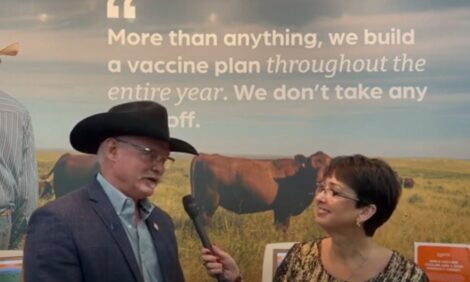



Abattoirs in Welfare Footage on Approved Export List
ANALYSIS - An Australian government investigation into footage of animal cruelty in four Indonesia abattoirs has concluded that two of the abattoirs were approved under a government scheme. The report also suggests that regulatory action be taken against two exporting companies, North Australian Cattle Company Pty Ltd (NACC) and International Livestock Export Pty Ltd (ILE), writes Charlotte Johnston, TheCattleSite editor.On 24 February 2012, the Department of Agriculture, Fisheries and Forestry (DAFF) received a formal complaint from Animals Australia alleging non–compliance with animal welfare guidelines that might involve cattle exported from Australia to Indonesia under an approved Exporter Supply Chain Assurance System (ESCAS). The complaint included video footage that Animals Australia said had been made on 24–26 January 2012. DAFF also received an RSPCA Australia analysis of the same video footage.
DAFF’s investigation of the complaint identified four abattoirs shown in the video footage. DAFF considered that four exporters had the potential to have an approved ESCAS that could have a link to an abattoir in the video footage.
The investigation determined that the slaughter lines shown in the video footage at two of the four abattoirs were part of an approved ESCAS for two exporters, and the slaughter lines at two abattoirs were not part of an approved ESCAS for any exporter.
At the two abattoirs determined to be part of an approved ESCAS, DAFF considers the cattle shown in the video footage made at one of the abattoirs to have been sourced from Australia. In the other abattoir, DAFF considers the cattle are highly likely to have been sourced from Australia.
At both these abattoirs, DAFF considers there to evidence of non–compliances with ESCAS animal welfare performance measures and targets.
The department has investigated the footage taken at the other two abattoirs and will not be taking any action as there is no evidence the animals involved were sourced from Australia.
Action against exporters
The investigation recommends that the Secretary take regulatory action with regard to the two exporters, North Australian Cattle Company Pty Ltd (NACC) and International Livestock Export Pty Ltd (ILE) with an approved ESCAS that each included an abattoir where non–compliances with ESCAS animal welfare performance measures and targets occurred.
Phillip Glyde, Deputy Secretary, DAFF said that the regulatory action taken compromises of removing the two abattoirs identified in the footage from each of these two exporters’ approved supply chains.
Additional conditions will also be placed on the two exporters, including having animal welfare officers present in all abattoirs in their approved supply chains where cattle are slaughtered using a modified Mark 4 restraint box without stunning.
The intensity of auditing of the exporter’s approved supply chains, where cattle are slaughtered using a modified Mark 4 restraint box without stunning, will also be increased.
Mr Glyde said that the exporters at this time did not face having their export licence removed.
"If further animal welfare breaches occur in these exporters’ supply chains, they face additional penalties under the relevant legislation, including the possible loss of their export license," he said.
In a statement, Elders has said that the one abattoir (out of 22) was found to not have performed satisfactorily against five performance measures, it confirms that the non compliance had nothing to do with animal cruelty.
"Elders considered the suggestions of non-compliances at Petir 1 to be extremely concerning, and acted
immediately once it was advised that grounds existed for investigation of the abattoir’s performance in
satisfying all of the ESCAS requirements under which it receives cattle from NACC."
Elders said it continues to endorse and support the ESCAS protocols.
"These non-compliances noted at Petir, whilst disappointing, also represent a small fraction of throughput
under the new system. This is an outcome which, given the intensity of ESCAS requirements and the
sheer scale of change in an accelerated timeframe it has required from many Indonesian stakeholders,
is understandable whilst also being encouraging for the achievement of satisfactory compliance."
CEO of the Australian Livestock Exporters’ Council, Alison Penfold praised the two exporters involved for undertaking the necessary remedial action immediately upon
notification of operational deficiencies, thus ensuring they comply with the requirements of ESCAS.
Ms Penfold said the new export arrangements have helped transform the way Australian animals
are managed through the export supply chain. Standards have been raised and the welfare
processes and practices that sit behind the new regulatory system, ESCAS, continue to improve.
"Even so, exporters are concerned that the Government’s regulatory response fails to credit the
remedial work undertaken by the two exporters involved and is unnecessarily heavy handed in
placing additional requirements on other facilities," she said.
“The Governments response adds significant extra cost burdens to the supply chain and does not
take into account that the ESCAS is a new system which sets unprecedented requirements on the
exporters that must be delivered in developing countries.
“To increase compliance measures on to other facilities which were not party to the investigation
and which are operated and staffed separately is a serious regulatory overreach.
"The industry remains committed to ESCAS and the wellbeing of the animals as they pass through
the supply chain. While any instances of non-compliance are regrettable, what this DAFF report
highlights is how just quickly industry responds to isolate and fix problems when they arise in order
deliver the required standards of animal welfare.”
The two other exporters initially identified by DAFF as potentially linked to the video footage were fully cleared of having any connection with the investigated footage. DAFF determined that these two exporters, Australian Rural Exports Pty Ltd (Austrex) and Wellard Rural Exports Pty Ltd (Wellard), did not have either of the relevant slaughter lines in their approved supply chains at the time the footage was taken.
In addition, DAFF agrees that the cattle filmed in the relevant sequences were not sourced from Australia. Accordingly, these exporters were excluded from any further part in the investigation.
Further action to be taken
The investigation also makes three general observations, including that additional requirements could be placed on all future export applications and that the Australian Chief Veterinary Officer conduct a further investigation into the Mark 4 restraint box when used without mechanical head and neck restraint.
Commenting on this, Australian Chief Veterinary Officer, Mark Schipp said: "I agree that a new assessment of the modified Mark4 restraint box is required. As Australia’s Chief Veterinary Officer I share the public’s concerns around the welfare of the animals featured in the footage under investigation.
The last assessment of Mark 1 and 4 restraint boxes was conducted in August 2011.
"That assessment found that proper use of the Mark 4 box for restraining and casting cattle for non-stun slaughter generally complied with elements of the OIE Code—Chapter 7.5 Slaughter of Animals.
"The more recent footage raises new concerns that were not apparent at the time of these earlier assessments. I consider them substantial enough to require further investigation."
Dr Shipp said that work on the report will begin immediately.
This investigation has taken place under Australia’s new regulatory system for live animal exports – ESCAS. The system includes procedures to investigate allegations of animal welfare breaches and to take appropriate action where required. The investigation also makes observations directed towards closing information and risk gaps that the investigation has revealed in the current process for approval of an ESCAS.
Further ReadingGo to our previous news item on this story by clicking here. |



